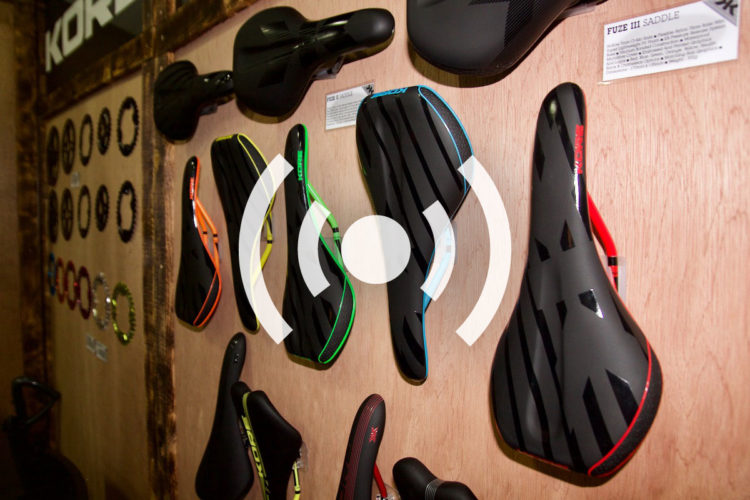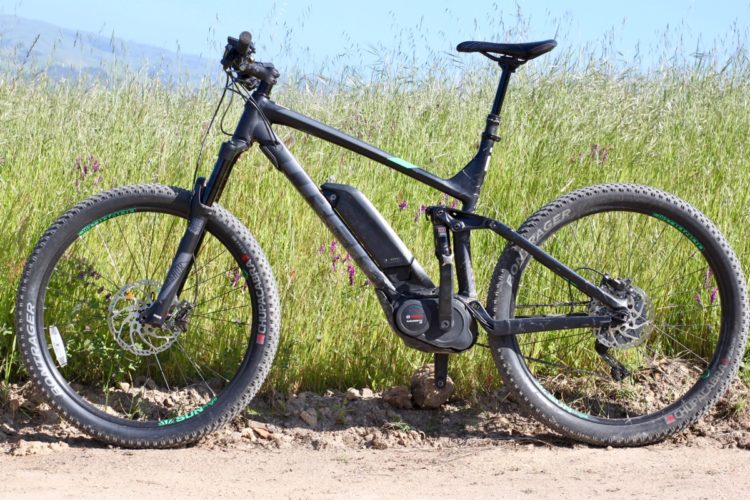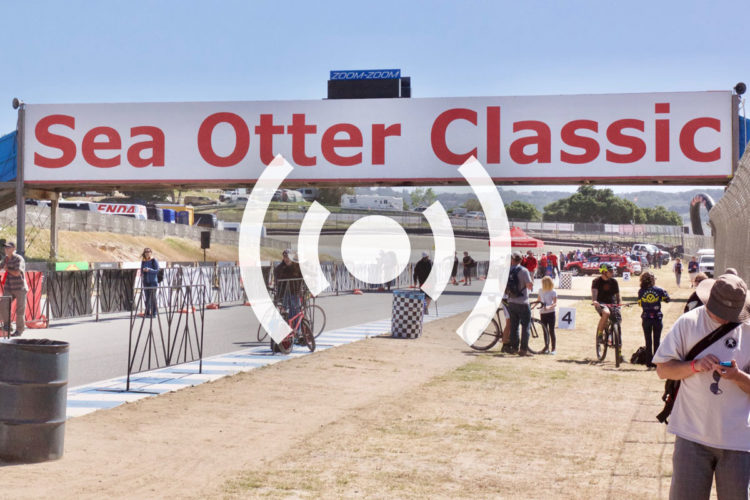
A handful of friends who work in the bike industry have been nudging me to try out an e-bike for the last couple of years. Their pleas go something like, “try it once and you will be hooked,” and “it is a totally different sport, and a different machine.” My personal favorite has to be, “you can train more with the electric motor.” I took all of this into consideration on my first assisted spin.
Every chance I’ve had to test a pedal-assisted bike came along when I had my pedal bike with me and had already planned a ride for the day. I recently dropped that excuse and decided to ride the next e-bike I was offered. While traipsing around the Roc d’Azur event, in Fréjus France, I stumbled upon Shimano’s demo tent and was invited to ride a bike with their new STEP E7000 series motor. Knowing that the tracks around Fréjus are technical and rocky in all of the best ways, I figured it was a perfect time to get a feel for the electric option.
The bike
Before I share my personal experience riding an e-bike for the first time, I’ll mention a few details about the bike and the new motor for context.
The bike I rode is an alloy Merida 120 500, outfitted with 27.5+ tires and the new Shimano STEPS E7000 electric motor. I would have preferred a bike with 2.6″ or narrower tires to limit the number of variables that were different from my pedal bike, but Shimano only had plus-size rubber on hand.
The new motor is a mid-level offering for consumers who don’t want or need the added power and price tag of Shimano’s flagship E8000. The motor offers three drive modes: Eco pushes the lowest amount of power and uses the least battery, Trail mode sits in the middle with slightly more power, and Boost mode is the max-power, battery-draining option.
At maximum speed, the motor’s assistance tops out at 25kph (15.5mph) which is quite fast when spinning up a steep climb.
The actual bike weight was not available, but it felt very heavy.

The ride
The ride, led by professional guides from H&I Adventures, took us away from the multitude of events at Roc d’Azur, and onto some tracks favored by locals. The guides made sure we had the opportunity to test all of the features of the new motor on steep technical climbs, lined with roots and rocks to finesse the bike over. We also hit a couple longer descents that gave a good indication of how the bike rides with the added weight of the motor and battery.
Everyone on the ride was instructed on the particulars of riding an e-bike, in contrast to a pedal bike. The short version of that story is that you want to spin more and let the motor get you up and over things. Mashing and sprinting doesn’t work so well on e-bikes. Additionally, they advised us to trust that the bike would climb nearly anything we wanted it to, and that once we learned to trust the bike we would be climbing things we would never dream of on a pedal bike.
The trails, instruction, and overall ride made for a fantastic test of the new motor and would be a great spot to test any bike. The site of a massive volcanic event, Fréjus’ trails are rocky and loose in every direction. I enjoyed the loop enough that when I returned to camp I mapped it out on my phone for a future pedal.

The feel of assistance
So, I tried it once, but am I hooked? Does the e-bike need to be looked at as a totally unique animal? Can I train more with pedal assist?
If asked to sum up my first e-bike experience in one word, I would choose “underwhelmed.” While the bike pedals like any other, and nearly all bikes can be fun in different ways, my overall experience of riding an e-bike was that it removed many of the things I love most about mountain biking.
I love the challenge of cleaning a technical climb, and the pedal assist made rocky steps feel like flat road climbs. As long as I was spinning, and had my weight close to the right balance point, the bike would just go up nearly anything. Balancing properly was also less challenging, as the bike itself is so heavy that you can essentially center your mass like you are on a motorcycle. The added tread patch of the 27.5+ tires may have played a part in this “endless traction” feeling.
I can see why folks with less time to ride or less interest in climbing might not care much about grinding through techy ascents, but the descending sensation of the e-bike is just as particular as its climbing prowess. The higher weight of the e-bike keeps it glued to the trail, and provides a noticeable plowing sensation through rougher sections of trail. The 120mm bike I was on felt more like a 140-160mm bike because I could point it at anything and it would bulldoze its way forward.
For my personal tastes, this plow sensation was not appreciated. I like a poppy bike that I can throw around and pump from one side of the track to another. For this reason, I typically keep my personal bikes as light as possible, with respect to their intended use. With the low-slung heft of the e-bike I felt stuck to the ground without a choice. The lively and playful characteristics of my pedal bike were replaced with a dull blundering sensation. Again, I can see where some riders may prefer to stay glued to the ground, and able to plow, but I will shred a pedal bike downhill over an e-bike any day.

Should the e-bike be approached from a different perspective entirely? This point I largely agree with. It is a bike, with two wheels, cranks, shocks, and all the other important bits, but from my experience, today’s e-bikes are designed for a different crowd of consumers. They require their own style of riding and rider mindset. If you approach a pedal-assist bike with a desire to push your own physical and mental limits to their breaking point you may also find yourself — underwhelmed.
Can you train more with an e-bike? This one doesn’t completely make sense to me. On the most basic level, the harder and longer I pedal, the more fitness I will gain from a given ride. Provided I rest, eat, and sleep properly, of course. How does a motor help that equation?
Arguably, you can do more laps downhill on an e-bike without using a gas-chugging shuttle, but you are on a bike with drastically different descending characteristics. I prefer to train on my race bike so I know how it feels at speed. Additionally, the batteries on these bikes only last 1.5-2hrs of hard riding in full assist mode, and some folks who are training seriously will want to ride a lot longer than that.
E-bike owners could fork over €350+ for a backup battery and throw that in a pack for resistance training. I climbed on the e-bike for about 15 minutes with the power turned off, and it was a painful experience. The added weight of the battery and motor make the assistance they provide necessary. If I owned this bike I would be concerned about blowing through the battery far from home and having to drag a boat anchor back to town.

Another side

I’ve made it clear that e-bikes are not my current jam, but I am happy to report that they provide heaps of stoke for a lot of people. Shimano has created an innovative product that is getting more people off of their couches and into the forest, now for less money. That is fantastic!
E-bike innovations have come a long way in the past several years, and virtually every company on the market is racing for the next step in that evolution. The E7000 motor recognizes when you put more power down and adds more power from the motor to match your input. With this new machine, riders can blast up climbs with aplomb, and don’t have to train heaps or have the highest level of fitness to do it. I can see why these innovations appeal to a wide variety of people.
These bikes are the right choice for somebody, and the 20+ e-bike riders I see on every rip in Finale Ligure indicate that they are here to stay. As pedal-assist prices continue to drop, the number of riders will inevitably grow.
For now, none of my ride partners has gone electric, but once they do, I’ll probably be the one gaining the most fitness trying to keep up on the climbs.





















21 Comments
Nov 16, 2018
Strangely enough I think my ebiking helped to improve my bike handling skills. I am afflicted with the worst target fixation imaginable. Tight switchbacks, whether up or down have always been a problem. Looking through a corner, riding a narrow path like a log...forget it. I've been working on the target fixation problem for 35 years, starting when I used to road race motorcycles, where looking ahead on corners is critical. But for some reason since I started riding the ebike these issues have begun to diminish quite a bit. Switchbacks and logs are now 99% doable without dabbing. I actually enjoy them for the first time ever. And pushing the ebike down when cornering is now something I do whereas before I tended to steer the bike around a corner. The plus sized tires probably has a lot to do with that owing to their grippiness.
It all sounds insane, I know. The reason may be as simple as I'm less gassed when on ebike rides.
As far a using an ebike as training for X/C racing? No. However as a recovery ride they can't be beat. That's what I did the last two seasons for my X/C race training. But I'm aging out in the 60+ class and there is no 65+ class at the venue I race. We'll see what my future holds.
Nov 17, 2018
I apologize for a comment that is nearly completely off topic but couldn't find the means to send a PM.
Your comment describes what I'm looking for in a bike for my wife. "I like a poppy bike that I can throw around and pump from one side of the track to another. For this reason, I typically keep my personal bikes as light as possible, with respect to their intended use." It seems to me the ability to lift the front end repeatedly at will reaps huge benefits on the trail. Keeping the bike light is going to help.
Am I out of line putting a short stem on a more XC oriented bike like the Pivot Mach 4 for her to use for AM/Trail purposes including the occasional trip down trails like Dupont Ridgeline or Barn Burner at Baker Creek? Reach and stack are actually lower than most AM/Trail bikes so the bike isn't "too long" as a result of its XC roots.
At 5'-1" and 120lbs so many bikes on the market seem overbuilt and as a result overweight for her needs. A XC rim or frame that would support a 200 pounder should be strong enough to absorb her biggest drops for years.
Are we likely to regret the loss of the additional 20-30mm of rear travel a Furtado or similar mount would provide?
Again sorry for going off topic but thanks for any help navigating the hype.
Nov 22, 2018
Nov 13, 2018
Nov 14, 2018
That’s surprising and unfortunate. First, I certainly don’t view a DB as less capable. It’s like someone with a Mercedes looking down at someone who drives a Camry when they both get the job done. If anything, I admire those with less capable bikes as it requires a lot more skill to ride the same terrain. I took my 23 year old fully rigid GT hybrid bike with rim brakes out when my FS bike was in the shop. It brought me back to when I first starting MTB’ing on that bike. I had to work harder, be more focused, take better lines, etc. To me, what makes this sport so great is the challenge and skill required and I think it’s unfortunate for those that are capable but choose to take the easy out.
Nov 13, 2018
Thank you for your balanced article!
Nov 13, 2018
Sidenote: your profile OTB photo is really great.
Nov 13, 2018
Nov 14, 2018
As luck would have it, the closest mtb playground to me is Surrey Hills. I'd long have bought a regular trail bike if the countryside around me was flatter but the ebike makes my nearby hills accessible. An additional bonus I didn't anticipate is that it makes the boring road sections to my closest trails a little less of a drag.
I find that on the flat, I frequently turn off the assistance if I don't feel myself actually pushing and use the lowest assist level most of the time.
The main downside I see is that although the battery with my usage pattern lasts for hours, I wouldn't feel comfortable going for a whole day cross country ride with just one.
Nov 13, 2018
The article mentioned battery life. I guess I hadn't considered battery life yet. If indeed they last 1 1/2-2 hours, that would be a limiting factor for an expensive ride. For me, anyway. That may work for most of my daily rides. But on weekends, I know I can spend a lot more time on the saddle, and without going to the parking lot (say, for a battery change) for hours at a time. I would guess longer rides aren't (yet) the target market for E bikes.
I'm also not 100% convinced E bikes are "just" and assisted ride. I guess that might depend on who's riding it, the model, etc. And then there's the hacker modifying things to make it faster. I know I'd be tempted. At one point at OuterBike, as a large group of us were grinding up a hill on the Razerback Regional Greenway in our lowest gears, an E bike passed us at what seemed like 10-15 MPH doing a wheelie (much faster than a sprinter). That's a lot of "assist". But it sure looked like fun! :)
Nov 13, 2018
Takes away many of the reasons I ride a bike uphill and isn't particularly rewarding to ride down again either - very plush but it's akin to riding an early 2000s downhill sled. Straight lines through anything rough. Not for me, though as you say I can see why that market exists, I'm just not in it. I'll be keeping my analogue remedy for now.
Nov 14, 2018
Nov 14, 2018
Nov 14, 2018
Nov 14, 2018
Nov 14, 2018
Nov 14, 2018
Nov 14, 2018
Nov 15, 2018
Q1. I think Oliver MA can better answer your fitness question, as I can only comment on this one ebike I rode one time. My sense is that it depends on what kind of fitness you are looking for. If you want to stay generally active and fit you should be able to do so on an ebike. If you want to train for hardcore racing that you will do on a pedal-bike, I don't understand how an ebike would help with that. I too wonder what the "X" factor is, and how many batteries it would take to do it. I suppose if you are training for gravity events and you ride an ebike on your rest days to practice DH skills, that could make sense. This would also eliminate the fuel consumption of a shuttle and allow you to work less on the climb. As I wrote above, I prefer to train on my race bike so I know precisely how it will react when it counts.
Q2. Likely there are more agile feeling ebikes that the one I was on. The bike I rode was a heavy alloy 120mm trail bike, with "plus size" tires, and loads of ways it could have been lighter. I can imagine a lighter ebike with 2.4" tires feeling more nimble and playful. That might diminish some of the plow sensations, and allow you to use some of those good old MTB skills. Oliver MA & Craige, what are your thoughts on the comparative skills aspect of ebike riding?
Nov 15, 2018
Nov 14, 2018